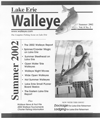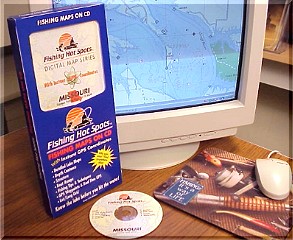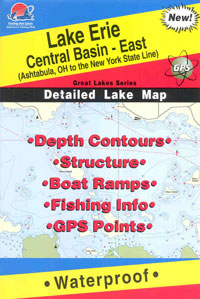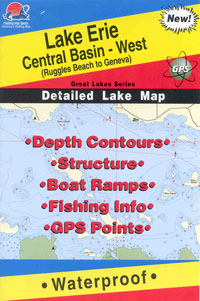Learn the principles of open water on
Erie and youíll be ready to take the technique anywhere in walleye country.
When walleye fishing, sometimes thereís no place like the middle of nowhere.
 Weíre
talking far from any underwater point, hump or weed bed. Weíre talking far
from flats, creek channels or any bottom-altering oddity that has fish
written all over it on electronics. Yes, weíre talking walleyes in the
middle of nowhere, open-water roamers that chase bait partway down in the
water column across miles of vast expanses.
Weíre
talking far from any underwater point, hump or weed bed. Weíre talking far
from flats, creek channels or any bottom-altering oddity that has fish
written all over it on electronics. Yes, weíre talking walleyes in the
middle of nowhere, open-water roamers that chase bait partway down in the
water column across miles of vast expanses.
Daunting? Maybe at first. Incredibly productive? You bet. The best
open-water walleye fishing on earth starts on Lake Erie in April and
continues throughout the year. Meanwhile, while walleyes tend to hang closer
to structure on inland waters until early summer, thatís when a percentage
of the population starts suspending. And thatís where and when you can
extend the principles of Erieís open-water trolling to anywhere in walleye
country.
To start trolling for middle-of-nowhere walleyes on Erie or anywhere
else, youíll need some specialized gear, a motor that will troll down to
slow speeds and a willingness to wander in search of wandering walleyes.
From there, successful open-water trolling depends to a large extent on
speed control and just what constitutes the best potential water in the
middle of nowhere. Even when youíre 15 miles from shore on Lake Erie or
Saginaw Bay, the smallest features make all the difference in the world.
Chairman of the Boards
For starters, gather up your planer boards and line-counter reels with
matching rods. The planer boards I use are by Church Tackle, and they come
in three sizes: the TX-6 Mini Planer, about the size of a deck of cards and
best for pulling lightly weighted spinners and unweighted crankbaits; the
TX-12, a great all-around board that will support up to two ounces of weight
with clip-on or inline weights; and the TX-24, a magnum board with lead
ballast to hold even heavier weights or even to troll with leadcore line.
Another asset of the Church Boards is the fact that the clips are easy to
open, making it quick and simple to get the board on and off the line.
For reels, check out the new C3 line-counters from Abu Garcia, which are
built on the tried-and-true 6500 frame and come with a sophisticated line
counter with LCD readout that can be calibrated for line size, type (even
superlines) and spool fill. If you already have a 6500, it's possible to buy
just the counter to install on C3 and C4 reels. All you do is remove the end
plate and slip the counter into place. Distance of baits behind boards,
weíll find out in a moment, is a crucial part of the equation. Next, team
the reels with the 7-foot, 10-inch Berkley Lightning Rod in the Signature
Series with telescopic butt section stout enough to hold up to 3- to 4-ounce
bottom bouncers off the boat without boards. The 8-foot, 6-inch model has a
softer tip that is perfect for trolling crankbaits and spinners with clip-on
weights on boardsčwith its flex, it also helps keep big fish from coming
unbuttoned. So does monofilament such as 10-pound-test Berkley Trilene XT,
which incorporates some stretch into the picture but has plenty of toughness
for landing monster walleyes.
Another key ingredient is a motor to troll at slow speeds Which ever kind
of motor it is your big motor or an auxiliary kicker it has to be able to
troll down to slow speeds for Erie walleyes in spring. If your big motor
doesnít idle down, you can often slow the progress of the boat with a pair
of 20-inch drift socks from JNB Originals, one on the starboard and one on
the stern. I also use them when trolling with my kicker motor in big waves
to smooth out my presentation and keep the boat from surging. For my kicker,
I use the Mercury 9.9-horsepower BigFoot four-stroke with a Panther
electronic steer. With the long 20-foot cord for the remote control, I can
steer from anywhere in the boat, and the Merc idles down to under 1 mph,
which is crucial in cold water.
Seek and Strain
On the water, the first thing I rely on is my electronics. The two most
important units in my boat are the Lowrance X-16, a color unit that spots
fish in vibrant reds whether theyíre a few feet under the surface or pinned
to the bottom, and the Global Map 3000. The Global Map is also critical
because it allows me to monitor trolling speeds to the tenth of a mile an
hour and accommodates mapping cartridges from Fishing Hot Spots. On the
electronic maps, I can see a wreck or a tiny bump in the bottom in the
middle of nowhere and troll over it. When I catch or mark fish, I put out
GPS waypoints so I can return and work the same fish time and again.
In spring on Erie, itís incredibly important to be able to mark fish and
bait. Sometimes I run with my big motor at 25 mph just looking for schools,
a possibility on the X-16 but an impossibility on most other units. (Tip:
Turn up the ping speed on the unit to help mark fish at high speeds.) I
might cover a couple of miles of open water, and then when I mark clusters
of fish, I punch in a waypoint and return later to fish them.
Nothing beats long, thin crankbaits for cold-water walleyes on the inland
seas. My favorites are No. 10 and No. 12 Rapala Deep Down Husky Jerks. Most
of the time I put them 30 to 80 feet behind the Church Boards to reach 10 to
15 feet, the most productive depth level Iíve found. At times, though, the
fish are even higher, in the top five feet, which necessitates putting out a
Husky Jerk a little as 15 feet behind the board. I also like the No. 9
Rapala Tail Dancer 35 feet behind the board to keep the bait at five or six
feet.
Since Iím trolling slowly, usually between 1.0 mph and 1.5 mph, Iím able
to use spinners at the same time. Tie up some harnesses with #2 hooks and
Northland holographic spinner blades. Iíve come to lose far fewer fish on
single hooks than on trebles, and the Northland blades give off the right
amount of flash to attract roaming walleyes from a distance. I weight them
with a 1 1/2-ounce Northland Rock Runner bottom bouncer when open-water
fishing, even though Iím nowhere near bottom. (Remember, Iím in the middle
of nowhere.) Iíll have about a six-foot leader between the spinner and the
bouncer and then experiment with the distance behind the board from 20 to 40
feet, again covering similar depths of eight to 18 feet. I put the bouncers
on the inside boards and the cranks on the outside boards.
The best part of the system is that itís not just for Erie anymore. In
summertime on inland lakes, I use the same technique but with higher-action
cranks such as Storm Hot Ćní Tots and ThunderSticks and smaller Northland
blades in size 3. For weight, I either stick with the bouncer or use Church
clip-on weights to get the spinners down. Later in the year, though, itís a
bit more difficult to fish cranks and spinners at the same time. Typically I
stick with one presentation over the other, pulling cranks at 2.0 mph and
spinners at 1.0≠1.6 mph. Once again, look for fish and bait on the
electronic and youíre in business.
Trolling for walleyes in the middle of nowhere undoubtedly requires an
attitude adjustment. Gone are the rock pinnacles and underwater castles that
are so productive in many situations. Now is the time to start searching far
and away from any underwater feature with electronics to find the fish and
begin straining the water column with crankbaits and spinners. The fish are
out there.






 Weíre
talking far from any underwater point, hump or weed bed. Weíre talking far
from flats, creek channels or any bottom-altering oddity that has fish
written all over it on electronics. Yes, weíre talking walleyes in the
middle of nowhere, open-water roamers that chase bait partway down in the
water column across miles of vast expanses.
Weíre
talking far from any underwater point, hump or weed bed. Weíre talking far
from flats, creek channels or any bottom-altering oddity that has fish
written all over it on electronics. Yes, weíre talking walleyes in the
middle of nowhere, open-water roamers that chase bait partway down in the
water column across miles of vast expanses.